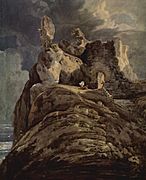Thomas Girtin facts for kids


Thomas Girtin (born February 18, 1775 – died November 9, 1802) was an English artist. He was famous for his watercolour paintings and etchings. Thomas Girtin was a friend and artistic rival of J. M. W. Turner. He played a very important part in making watercolour painting a respected art form.
Contents
Life of Thomas Girtin
Thomas Girtin was born in Southwark, London. His father was a wealthy brushmaker from a French family called Huguenots. Thomas's father died when he was young. His mother then married Mr. Vaughan, who was a pattern-draughtsman.
Early Training and Friendships
Thomas learned to draw as a boy. He took classes with Thomas Malton. Later, he became an apprentice to Edward Dayes. Dayes was an artist who drew landscapes and buildings using watercolours. Thomas likely finished his seven-year training. There were some stories of disagreements between Thomas and his teacher. Dayes did not seem to value Girtin's talent much.
When he was a teenager, Girtin became friends with the young artist J. M. W. Turner. Both boys worked together colouring old prints with watercolours. Girtin began showing his art at the Royal Academy in 1794.
Growing Fame and New Style
His drawings of buildings and places made him well-known. He used watercolour for landscapes in a new way. This helped create the Romantic style of watercolour painting. He traveled around England to sketch. He visited the north of England, North Wales, and the West Country.
By 1799, important people started to support his art. These included Lady Sutherland and the art collector Sir George Beaumont. Girtin was a leading member of "the Brothers." This was a group of artists and talented amateurs who met to sketch.
Later Life and Work
In 1800, Girtin married Mary Ann Borrett. She was 16 years old and the daughter of a rich City goldsmith. They made their home in St George's Row, Hyde Park. Their neighbour was another painter, Paul Sandby.
By 1801, Girtin's health was getting worse. Despite this, he was a welcome guest at the country homes of his supporters. These included places like Harewood House and Mulgrave Castle. He could charge a good amount of money for a painting.
From late 1801 to early 1802, Girtin spent about five months in Paris. There, he painted many watercolours. He made a series of pencil sketches. He then engraved these sketches when he returned to London. They were published after his death as Twenty Views in Paris and its Environs.
In 1802, Girtin created a huge painting of London called the "Eidometropolis." It was about 5.5 meters (18 feet) high and 33 meters (108 feet) around. This painting was shown that same year. People admired it for how naturally it showed the light and air of the city.
In November 1802, Girtin died in his painting room. He was only 27 years old. The cause of his death was reported as asthma, consumption, or a heart problem. He was buried in the churchyard of St Paul's, Covent Garden in London.
Style and Technique

Girtin's early landscape paintings looked like typical 18th-century sketches of places. But later, he developed a bolder and more open style. This new, romantic style had a lasting impact on English painting. The scenery of northern England inspired him to use new colours. He used warm browns, slate greys, indigo, and purple.
He stopped the old way of painting. This old way involved first shading with grey wash, then adding small patches of colour. Instead, Girtin used large washes of strong colour. He also tried using pen, brown ink, and varnish to make his colours richer.
It is said that when Thomas Girtin died young, Turner remarked, "If Tom Girtin had lived, I would have starved." This shows how much Turner respected Girtin's talent. Girtin's most famous work is The White House at Chelsea (1800). Turner greatly admired this painting.
Exhibitions of His Work
The British Museum and the Victoria and Albert Museum have collections of Girtin's artworks. The British Museum received watercolours from a collector named Chambers Hall. In July 2002, Tate Britain held an exhibition. It was called Thomas Girtin: The Art of Watercolour. This show aimed to "reveal his technical genius."
Gallery
See also
 In Spanish: Thomas Girtin para niños
In Spanish: Thomas Girtin para niños












